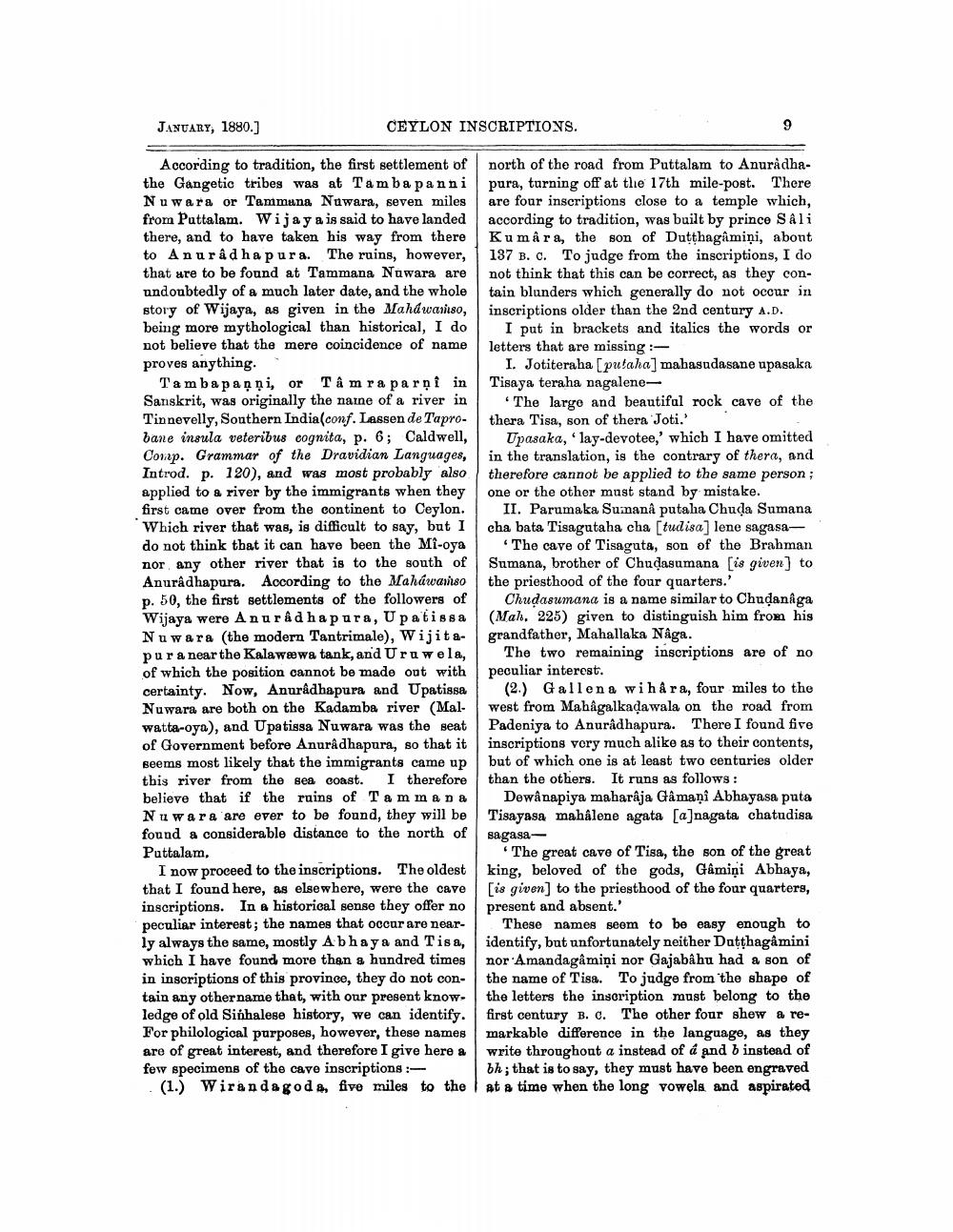________________
JANUARY, 1880.]
CEYLON INSCRIPTIONS.
According to tradition, the first settlement of north of the road from Puttalam to Anuradhathe Gangetic tribes was at Tamba panni pura, turning off at the 17th mile-post. There Nuwara or Tammuna Nuwara, seven miles are four inscriptions close to a temple which, from Puttalam. Wijaya is said to have landed according to tradition, was built by prince Sali there, and to have taken his way from there Kumara, the son of Dutthagamiņi, abont to Anuradhapura. The ruins, however, 137 B. C. To judge from the inscriptions, I do that are to be found at Tammana Nuwara are not think that this can be correct, as they conundoubtedly of a much later date, and the whole tain blunders which generally do not occur in story of Wijaya, as given in the Mahdwariiso, inscriptions older than the 2nd century A.D. being more mythological than historical, I do I put in brackets and italics the words or not believe that the mere coincidence of name letters that are missing :proves anything.
I. Jotiteraha (putaha] mahasudasane upasaka Tambapaņņi, or Tâmra parni in Tisaya teraha nagaleneSanskrit, was originally the name of a river in The large and beautiful rock cave of the Tin nevelly, Southern India(conf. Lassen de Tapro- thera Tisa, son of thera Joti. bane insula veteribus cognita, p. 6; Caldwell, Upasaka, 'lay-devotee,' which I have omitted Comp. Grammar of the Dravidian Languages, in the translation, is the contrary of thera, and Introd. p. 120), and was most probably also therefore cannot be applied to the same person; applied to a river by the immigrants when they one or the other must stand by mistake. first came over from the continent to Ceylon. II. Parumaka Sumanâ putaha Chuda Sumana Which river that was, is difficult to say, but I cha bata Tisagutaha cha [tudisa] lene sagasado not think that it can have been the Mi-oya "The cave of Tisaguta, son of the Brahman nor any other river that is to the south of Sumana, brother of Chudasumana [is given] to Anuradhapura. According to the Maháwainso the priesthood of the four quarters.' p. 50, the first settlements of the followers of Chudasumana is a name similar to Chudanaga Wijaya were Anuradhapura, U patissa (Mal. 225) given to distinguish him from his Nuwara (the modern Tantrimale), Wijita- grandfather, Mahallaka Naga. pura near the Kalawewa tank, and Uruwela, The two remaining inscriptions are of no of which the position cannot be made out with peculiar interest. certainty. Now, Anuradhapura and Upatissa (2.) Gallena wihå ra, four miles to the Nuwara are both on the Kadamba river (Mal. west from Mahagalkadawala on the road from watta-oya), and Upatissa Nuwara was the seat Padeniya to Anuradhapura. There I found five of Government before Anuradhapura, so that it inscriptions very much alike as to their contents, seems most likely that the immigrants came up but of which one is at least two centuries older this river from the sea coast. I therefore than the others. It runs as follows: believe that if the ruins of Tamman a Dewanapiya maharaja Gâmani Abhayasa puta Nuwara are ever to be found, they will be Tisayasa mahâlene agata [a]nagata chatudisa found a considerable distance to the north of sagasaPuttalam,
The great cave of Tisa, the son of the great I now proceed to the inscriptions. The oldest king, beloved of the gods, Gâmiņi Abhaya, that I found here, as elsewhere, were the cave [is given] to the priesthood of the four quarters, inscriptions. In a historical sense they offer no present and absent. peculiar interest; the names that occur are near- These names seem to be easy enough to ly always the same, mostly Abhaya and Tisa, identify, but unfortunately neither Datthagamini which I have found more than a hundred times nor Amandagâmiņi nor Gajabâ hu had a son of in inscriptions of this province, they do not con- the name of Tisa. To judge from the shape of tain any other name that, with our present know- the letters the inscription must belong to the ledge of old Sinhalese history, we can identify. first century B. C. The other four shew a reFor philological purposes, however, these names markable difference in the language, as they are of great interest, and therefore I give here a write throughout a instead of á and b instead of few specimens of the cave inscriptions :
bh; that is to say, they must have been engraved (1.) Wiranda gode, five miles to the at a time when the long vowels and aspirated




